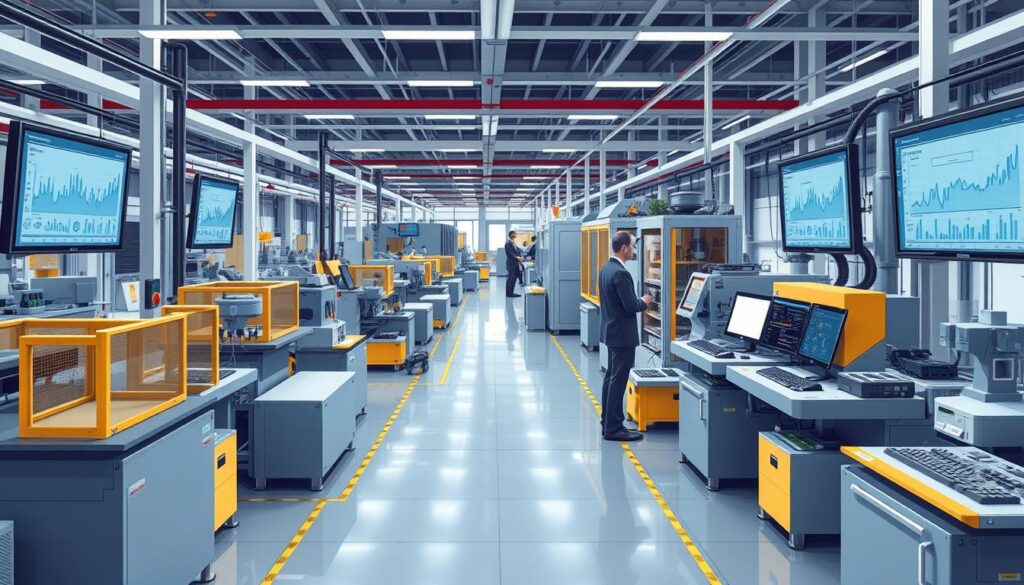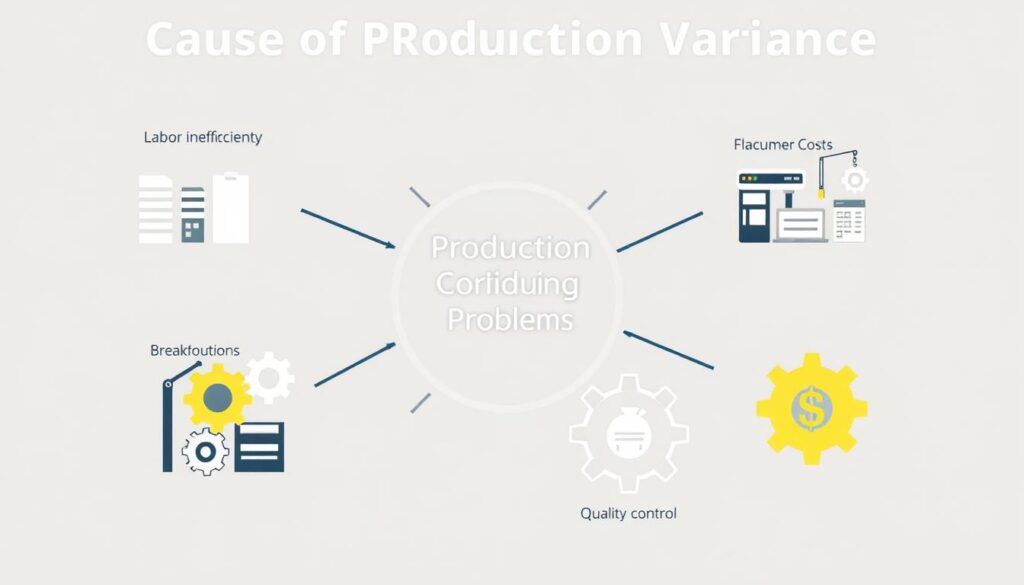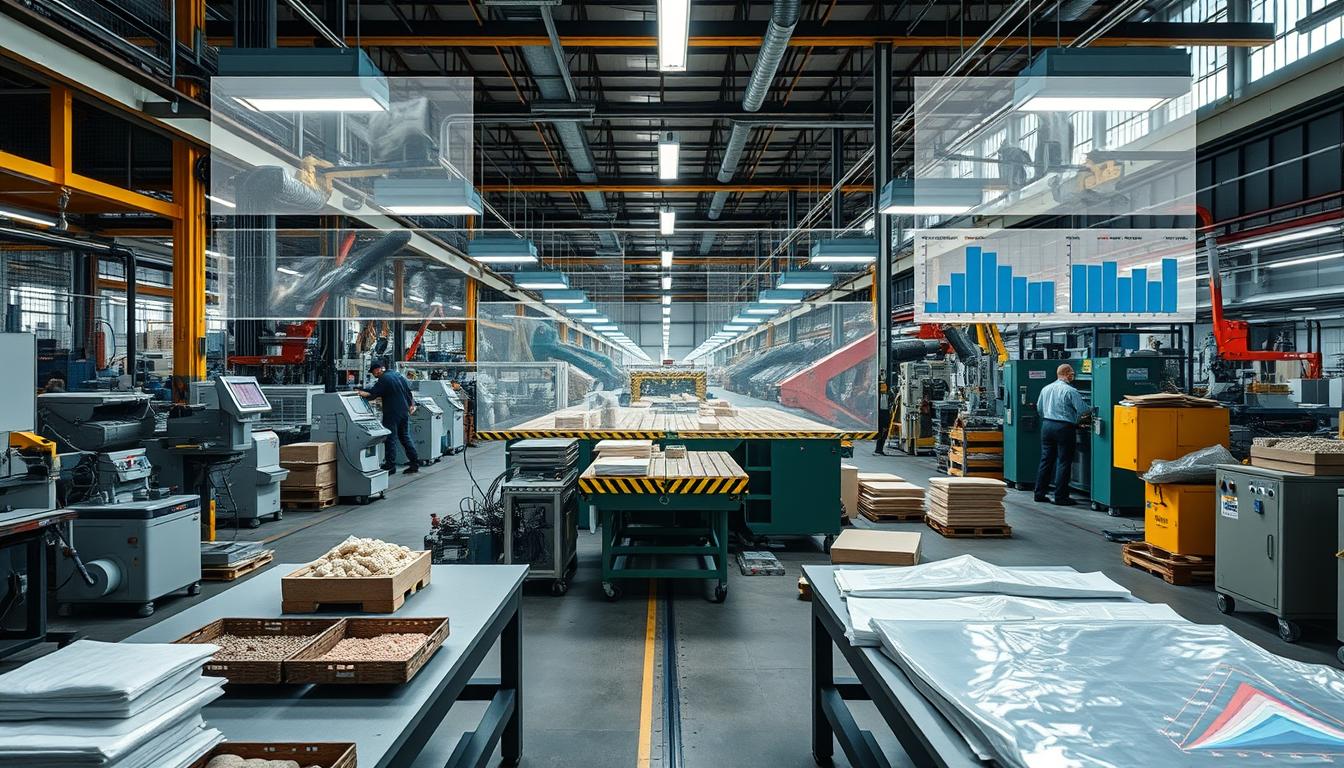Have you ever seen your plans go off track? It happens often in the fast world of manufacturing. You might spend hours planning your budget. Then, unforeseen costs suddenly appear. That’s why getting a grip on production variance in SAP matters so much. It acts as a guide through the complex world of making things. By mastering it, you can find ways to work more efficiently and save money.
Let’s explore the ins and outs of production variance. You’ll see how SAP’s powerful ERP solutions help make your manufacturing better. This trip will show you how to keep reality and planning aligned. That way, you’ll have what you need to keep your operations under control.
Key Takeaways
- Understand the importance of production variance in SAP for effective cost management.
- Learn about the eight categories of variance that can impact your manufacturing process.
- Explore the steps involved in analyzing production variance to distinguish between planned and actual quantities.
- Utilize SAP S/4HANA to enhance your manufacturing strategies and gain real-time insights.
- Discover the recommended functionalities for variance analysis, including actual costing and Material Ledger.
What is Production Variance?
Understanding production variance is key for those in manufacturing. It looks at the differences between expected and real costs. Production variance shows how well a company is doing financially and how efficient its operations are.
Definition and Importance
Its role in manufacturing is crucial. Spotting production variance helps see if production methods work well and if resources are used right. By checking these variances, companies can find what’s not working and plan better for the future.
Types of Production Variance
Manufacturers should know about several types of production variance:
- Material Variance: Shows the gap in material costs, looking at actual vs. expected raw material costs.
- Labor Variance: Deals with changes in labor costs due to overtime, different wages, or productivity changes.
- Overhead Variance: Talks about the difference in indirect costs, like equipment depreciation or utilities, affecting profit.
Knowing these production variance types helps tackle manufacturing issues and boost efficiency.
Understanding Production Variance in SAP
SAP is crucial in today’s manufacturing. It lets companies smoothly handle their supply chains and production. A key part is managing production variances. This tracks the differences between expected and actual results.
Role of SAP in Manufacturing Processes
SAP helps streamline operations in manufacturing. It offers robust tools for making decisions based on data. This allows for quick reactions to changes in production. SAP serves as a central place for collecting data. It helps find areas that need improvement. This boosts manufacturing efficiency, cuts waste, and uses resources wisely.
Key Features of Production Variance in SAP
SAP’s production variance management has many important features. These include:
- Comprehensive reporting tools for insights into variance types, like cost center and purchase price.
- Integration with other business areas to systematically manage variances.
- Real-time data analysis for fast production adjustments based on current metrics.
- Material ledger support, crucial in tracking material costs and variances in SAP S/4HANA.

Using these SAP features helps manufacturers react quickly to variances. This keeps operations running smoothly and boosts productivity. SAP not only offers tools for tracking production variances. It also encourages ongoing improvement. This moves your company toward its manufacturing goals.
Causes of Production Variance
Knowing why production variance happens is key for good manufacturing management. By figuring out these reasons, you can find ways to reduce their bad effects. This part talks about three main kinds of variances: material, labor, and overhead cost.
Material Variance
Material variance comes from different main reasons that change production costs. Price changes in the market and using more or less materials than planned are common causes. The material usage variance shows the gap between actual and standard material amounts. Meanwhile, material rate variance looks at cost changes from using different materials or price shifts. Watching these variances helps you see how material costs affect overall production variance.
Labor Variance
Labor variance is usually due to changes in labor costs. This could be from unexpected overtime, work not done well, or actual labor rates not matching planned ones. Looking at labor usage and rate variances helps show how real labor costs differ from planned ones. Things like overtime and work efficiency have a big impact on labor costs and production variance. It’s important to keep an eye on these factors for better processes.
Overhead Cost Variance
Overhead cost variance comes from not correctly assigning indirect costs or changes in how efficient operations are. If real overhead costs don’t match the planned ones, it leads to an overhead cost variance. This can hurt profits. It’s crucial to correctly assign overhead costs to understand their effect on production variance. Paying attention to these variances helps allocate resources better and improve manufacturing activities.

| Type of Variance | Key Causes | Impact on Production |
|---|---|---|
| Material Variance | Market price fluctuations, wastage, discrepancies in expected material requirements | Increased production costs, reduced profit margins |
| Labor Variance | Unexpected overtime, inefficiency, discrepancy between planned and actual rates | Higher labor costs, potential delivery delays |
| Overhead Cost Variance | Improper allocation, changes in operational efficiency | Inconsistent budgeting, reduced profitability |
Analyzing Production Variance in SAP
In the world of making things, it’s key to check production variance well. SAP’s tools let companies thoroughly explore the gaps between planned and real costs. These tools point out important patterns and exceptions, leading to smarter decisions.
Reporting Tools in SAP
SAP has many tools for looking at production variance. A main one is the work order variance report. It’s great for comparing planned costs with real costs. But, these reports must have accurate info about work orders, time planned, labor, and materials used. If not, the analysis might be off.

Key Performance Indicators (KPIs) for Production Variance
Finding the right KPIs for production can improve your analysis a lot. Important measures could be:
- Variance percentage
- Budget adherence
- Efficiency ratios
Keeping an eye on these KPIs helps you see if production meets financial and operational plans. It means you’re always looking at production variance to spot improvement spots. This continuous review not only reveals mismatches but also leads to actions for better production methods.
Managing Production Variance Effectively
Managing production variance well improves overall operational efficiency. To do this, use proactive methods that spot and fix variances early. These strategies are crucial for good variance management.
Strategies for Minimizing Variance
To lessen variance, apply certain strategies for big gains. Here are some key ones:
- Improving forecasting techniques: Better forecasting reduces demand and supply changes, cutting variance.
- Engaging in supplier negotiations: Strong supplier relationships lessen material variance and improve delivery times.
- Streamlining processes: Better production workflows mean more efficient work, reducing labor variance.
- Utilizing integrated planning: Use tools like SAP S/4HANA Finance for better operations alignment, aiding variance control.
- Regular variance analysis: Continuously check variance results for quick fixes.
Continuous Improvement Practices
Continuous improvement, with methods like Six Sigma, focuses on operational excellence. These steps are involved:
- Do regular checks to find areas that need work.
- Make specific changes based on the data from variances.
- Promote team work for innovative thinking.
- Use quick, automated calculations for up-to-date variance info.
Adopting continuous improvement helps tackle present production variances and stops future issues. Continual reviews and changes lead to lasting improvements in variance.

Benefits of Reducing Production Variance
Lowering production variance leads to many positive outcomes for your manufacturing process. These benefits make your organization run more smoothly and profitably.
Cost Savings
One major advantage of decreasing variance is significant cost reductions. By reducing waste, companies spend less on operations. A thorough analysis could help slash production expenses by 15% to 30%. Also, better inventory control means fewer shortages or surplus, saving up to 20%.
Enhanced Efficiency and Productivity
A decrease in production variance means work is done more efficiently. This aligns production plans with available resources, improving their use by 20% to 30%. Digging into variance data promotes decisions that cut down production time by 10% to 20%. Companies can then make more products faster, without sacrificing quality.

| Benefit | Description | Potential Impact |
|---|---|---|
| Cost Savings | Reduction in waste and improved cost tracking. | 15% to 30% decrease in production costs. |
| Inventory Optimization | Minimized stock-outs and excess inventory. | Up to 20% cost savings. |
| Decision Making | Data-driven insights for informed choices. | 10% to 20% reduction in cycle time. |
| On-Time Delivery | Improved scheduling and efficiency. | Up to 25% increase in on-time delivery rates. |
| Customer Satisfaction | Higher quality and reliability of products. | 10% to 15% increase in customer satisfaction rates. |
Conclusion
Understanding production variance in SAP is crucial for your business. It helps you see how variances impact manufacturing. By spotting the main causes of variances and using SAP’s tools, you can manage variance well. This method helps spot differences early and adjust to meet financial goals.
Integrating processes like cost estimation and cost collection improves efficiency. SAP S/4HANA Finance offers detailed insights, highlighting production issues. Through regular reports, your company can save costs and boost productivity. This leads to a quicker, more flexible manufacturing process.
Your dedication to mastering production variance affects manufacturing positively. Using SAP’s metrics and focusing on eight variance categories encourages ongoing improvement. By applying these strategies, managing production variance goes beyond cutting costs. It enables your company to succeed in a changing market.









